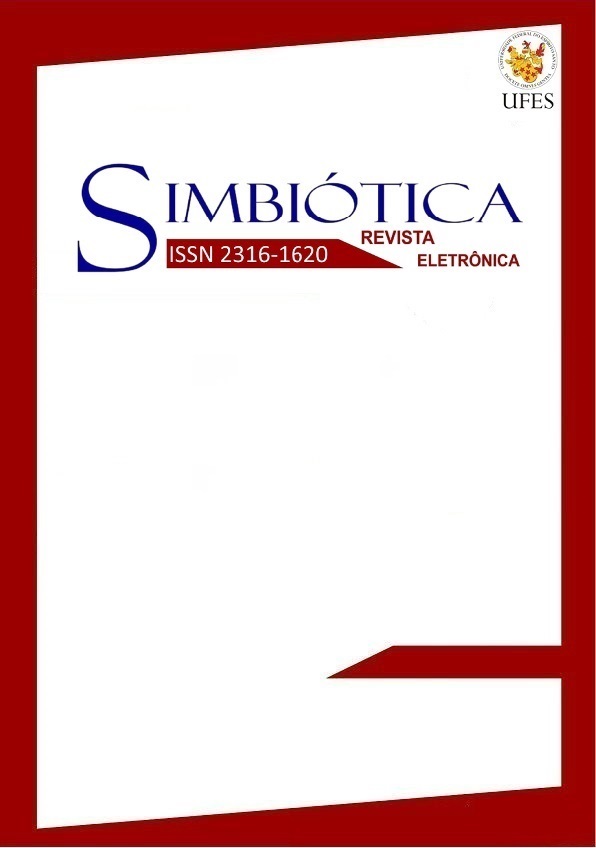Relaciones de continuidad: lenguaje y naturaleza. Un diálogo entre la antropología de Tim Ingold y la topología de Jacques Lacan
DOI:
https://doi.org/10.47456/simbitica.v4i1.19453Resumo
Resúmen: Sobre el problema antropológico de la distinción entre naturaleza y cultura, este trabajo se propone realizar un paralelismo entre la crítica de Tim Ingold y la topología del concepto de pulsión en el psicoanálisis de Lacan. Para esto se intentará delimitar, en primer lugar, el estatuto del lenguaje en la relación cultura/naturaleza a partir de las posiciones de Ingold, David Parkin, Alfred Gell y, fundamentalmente, Claude Lévi-Strauss. Luego, se buscará realizar un pasaje hacia la categoría de pulsión como elemento crítico que, a través de su definición como límite entre lo representativo y lo somático, puede realizar un aporte teórico al planteo fundamental de Ingold.
Palabras clave: Cultura; lenguaje; pulsión; topología.
Resumo: Sobre o problema antropológico da distinção entre natureza e cultura, este trabalho tem como objetivo fazer um paralelo entre a crítica de Tim Ingold e a topologia do conceito de pulsão na psicanálise de Lacan. Para isso, vamos tentar definir, em primeiro lugar, o estatuto da língua na relação cultura / natureza a partir das posições de Ingold, David Parkin, Alfred Gell e, fundamentalmente, Claude Lévi-Strauss. Em seguida, procura-se fazer uma passagem para a categoria de pulsão como elemento crítico que, através da sua definição como uma fronteira entre o representacional eo somático, pode fazer uma contribuição teórica para a questão fundamental de Ingold.
Palavras-chave: cultura; linguagem; pulsão; topología.
Abstract: On the anthropological problem about the distinction between nature and culture, this work aims to make a parallel between Tim Ingolds critic and the topology of the drive concept in Lacans psychoanalysis. For this, we will try to define, firstly, the status of language in the culture/nature relationship from the standpoints of Ingold, David Parkin, Alfred Gell and, mainly, Claude Lévi-Strauss. Then, we will try to pass towards the concept of drive as a critical element that, through its definition as a limit between the representative and the somatic, can make a theoretical contribution to Ingolds fundamental thesis.
Keywords: culture; language; drive; topology.
Referências
BENVENISTE, E. (1997). Problemas de lingüística general. Tomo 1. México: Siglo 21.
______. (2014). Últimas lecciones: Collège de France 1968-1969. Buenos Aires: Siglo 21.
EIDELSZTEIN, A. (2007). El grafo del deseo. Buenos Aires: Letra Viva.
______. (2012). La topología en la clínica psicoanalítica. Buenos Aires: Letra Viva.
FREUD, S. (1979). “Pulsiones y destinos de pulsión”. En: Obras completas, volumen XIV. Buenos Aires: Amorrortu.
GELL, A. (2005). “Against the motion 1”. En: Ingold (Ed.) Key debates in social anthropolgy. London: Routledge. pp. 129-135.
INGOLD, T. (2004). “Beyond biology and culture. The meaning of evolution in a relational world”. Social Anthropology. Reino Unido: European Association of Social Anthropologists. v. 12, n. 2, pp. 209-221.
______. (2005). “Introduction: 1991 debate Language is the essence of culture”. En: Ingold (Ed.) Key debates in social anthropolgy. London: Routledge. pp. 122-125.
______. (2010). “Bringing things to life: Creative Entanglements in a World of Materials”. En: Realities. University of Manchester. Workingpaper n.15.
LACAN, J. (2005). El seminario: libro 7: La ética del psicoanálisis. Buenos Aires: Paidós.
______. (2012). El seminario: libro 11: Los cuatro conceptos fundamentales del psicoanálisis. Buenos Aires: Paidós.
LÉVI-STRAUSS, C. (1997). “La estructura de los mitos”. En: Antropología estructural. Barcelona: Altaya. pp. 229-252.
______. (2013). “Diálogo con Claude Lévi-Strauss”. En: Elogio de la antropología. Buenos Aires: El cuenco de plata. pp. 53-92.
______. (2014). El pensamiento salvaje. Buenos Aires: Fondo de Cultura Económica.
MOERAN, B. (2005). “For the motion 2”. En: Ingold (Ed.) Key debates in social anthropolgy. London: Routledge. pp. 135-139.
PARKIN, D. (2005). “For the motion 1”. En: Ingold (Ed.) Key debates in social anthropolgy. London: Routledge. pp. 126-129.
SAUSSURE, F. de (2007). Curso de lingüística general. 2 Tomos. Buenos Aires: Losada.
Downloads
Publicado
Edição
Seção
Licença
Copyright (c) 2020 Santiago Esteban Peppino

Este trabalho está licenciado sob uma licença Creative Commons Attribution-NonCommercial-NoDerivatives 4.0 International License.
Autores que publicam nesta revista concordam com os seguintes termos:
a. Autores mantém os direitos autorais e concedem à revista o direito de primeira publicação, com o trabalho simultaneamente licenciado sob a Creative Commons - Atribuição-NãoComercial 4.0 Internacional.
b. Compartilhar - copiar e distribuir o material em qualquer meio ou formato.
Adaptar - remix, transformar e construir sobre o material para qualquer finalidade, inclusive comercial.
c. Autores têm autorização para assumir contratos adicionais separadamente, para distribuição não-exclusiva da versão do trabalho publicada nesta revista (ex.: publicar em repositório institucional ou como capítulo de livro), com reconhecimento de autoria e publicação inicial nesta revista.
d. Autores têm permissão e são estimulados a publicar e distribuir seu trabalho online (ex.: em repositórios institucionais ou na sua página pessoal) a qualquer ponto antes ou durante o processo editorial, já que isso pode gerar alterações produtivas, bem como aumentar o impacto e a citação do trabalho publicado (Veja O Efeito do Acesso Livre).
Authors who publish in this journal agree to the following terms:
a. Authors retain the copyright and grant the magazine the right of first publication, with work simultaneously licensed under the CCreative Commons - Atribuição-NãoComercial 4.0 Internacional.
b. Share - copy and distribute the material in any medium or format.
Adapt - remix, transform and build on the material for any purpose, including commercial.
c. Authors are authorized to take additional contracts separately, for non-exclusive distribution of the version of the work published in this journal (eg, publish in institutional repository or as a book chapter), with acknowledgment of authorship and initial publication in this journal.
d. Authors are allowed and encouraged to publish and distribute their work online (eg.: in institutional repositories or on their personal page) at any point before or during the editorial process, as this can generate productive changes as well as increase the impact and the citation of the published work (See The Effect of Free Access).










